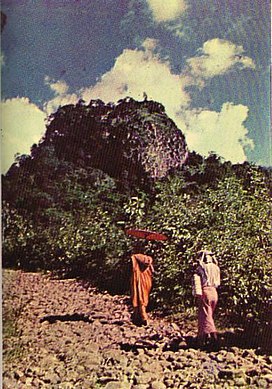Pegu Range
| Pegu Range | |
|---|---|
| ပဲခူးရိုးမ | |
 Mount Popa | |
| Highest point | |
| Peak | Mount Popa |
| Elevation | 1,518 m (4,980 ft) |
| Coordinates | 20°55′27″N 95°15′02″E / 20.92417°N 95.25056°E |
| Dimensions | |
| Length | 475 km (295 mi) N/S |
| Width | 60 km (37 mi) E/W |
| Geography | |
| Country | Burma |
| Range coordinates | 20°55.3′N 95°14.9′E / 20.9217°N 95.2483°E |
The Pegu Range (
High points
Among the notable peaks or hilltops are 1,518 metres (4,980 ft) high Mount Popa, a stratovolcano,[3]Sinnamaung TAUNG 2,693 feet (820 m), Shwenape TAUNG 2,509 feet (765 m), TALAN TAUNG 2,050 feet (625 m), Binhontaung 2,003 feet (611 m),[4] Kodittaung 1,885 feet (575 m),[4] Phoe-Oo Taung [3] and Singguttara Hill (Theingottara Hill).[3]
Geology
The Pegu Range consists of folded and faulted
History
The Shwedagon Pagoda was built sometime before 1000 A.D. on Singguttara Hill.
The Pegu Range was the original site of the 1930-1931
Later the Pegu Range became a center for the Communist Party of Burma.[6]
Ecology
The northern end of the Pegu merges into the Burmese Dry Belt, while in the south there is over 80 inches of rainfall a year.[7] The hills of the Pegu Range were originally heavily forested with teak and other commercially exploitable hardwoods.[1][7] The southern forests were "ironwood forests", while the central and northern forests were teak.[8] Extensive logging has caused the present deforestation and increased erosion in the area.
Notes
- ^ ISBN 0-8108-5476-7
- ISBN 0-8108-5476-7
- ^ ISBN 974-9863-31-3
- ^ a b topographic map, 1:250,000 Thayetmyo, Burma, NE 46-4, Series U542, United States Army Map Service, October 1959
- ISBN 0-8248-2207-2
- ISBN 0-8108-5476-7
- ^ a b Stamp, L. Dudley (1930) "Burma: An Undeveloped Monsoon Country" Geographical Review 20(1): pp.86-109, page 105
- ^ de Terra, Hellmut (1944) "Component Geographic Factors of the Natural Regions of Burma" Annals of the Association of American Geographers 34(2): pp. 67-96, page 82

